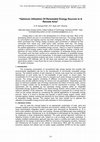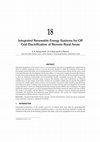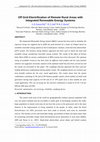Papers by Amarsingh Kanase-Patil
Energy, 2011
An Integrated Renewable Energy Optimization Model (IREOM) model has been developed for sizing and... more An Integrated Renewable Energy Optimization Model (IREOM) model has been developed for sizing and optimization of renewable energy systems based on seasonal variation in the load profiles of the study area. An attempt has been made to develop correlations between renewable energy system sizes and their capital cost for the user specified system sizes. The developed correlations were used for the analysis of IREOM model using user specified system sizes and compared with manufacturer specified system sizes. The cluster of seven unelectrified villages having micro-hydro power, biomass, wind and solar energy resources in the state of Uttarakhand, India has been considered for the implementation of IREOM model. Based on the results obtained from the proposed model, suitable sizes of renewable energy systems have been suggested.

Energy plays a vital role in the development of a remote rural area. Most of the developing natio... more Energy plays a vital role in the development of a remote rural area. Most of the developing nations are poor in conventional fossil fuel resources. The energy demand, its consumption and tapping sources has been changing with time. Usable energy is either purchased from Energy Supply Company (grid connected) or obtained as free commodity from nature (e.g. small hydro, solar, biomass, wind etc). The energy planning is proposed for a remote area to meet out the energy demand by considering the optimal applications of renewable energy sources. There is a need to develop and operate a hybrid energy system model, which includes lighting, heating, cooking, and electricity for local industry using different combination of renewable energy sources. The present work has been carried out to optimise the utilization of renewable energy sources with emphasis on micro hydropower. In this paper a pre-feasibility study of cost of biomass using sensitivity analysis was done. A remote cluster of villages with energy consumption 623 kWh/day with 59 kW peak load demand was considered as the stand-alone system. It was found that as cost of biomass increases the contribution of PV system increases.
More than two billion people worldwide have currently no access to grid electricity or other ener... more More than two billion people worldwide have currently no access to grid electricity or other energy supply means and the majority live in remote rural areas. The living standard of these people is not being improved due to their reliance on traditional fuels and technologies. Energy is the key element that can be help having for property and overall development. Renewable energy has been viewed to have the potential to supply green power to these areas. This paper discusses the concept of various renewable energy options and their utilization to meet the energy needs of people and communities. The development and application of Integrated Renewable Energy System (IRES) for the energization of such areas has been discussed including sizing of conversion technologies & optimisation of combination of various sources.

Substantial proportions of the world’s poor live in remote rural areas that are geographically is... more Substantial proportions of the world’s poor live in remote rural areas that are geographically isolated and are often too sparsely populated or have a very low electricity demand to justify the extension of the grid. In developing countries like India, most of its population lives in rural remote areas with no grid electricity, which is the main obstacle in the development of such areas. Hence, it is necessary to supply the renewable electricity to these areas in decentralized mode. Renewable energy sources are the least cost and most feasible solutions, as these are unlimited, inexhaustible and environmental friendly sustainable resources. The remote rural villages have substantial renewable energy resources, like biomass, solar, wind, hydropower etc. Different manifestations of solar energy (wind, hydro, biomass etc) are highly variable and site specific. The problem caused by the variable nature of these resources can be partially overcome by either installing individual large renewable power plant, or adding energy storage and reconversion facilities and / or by integration. To meet the energy demand of a rural area, Integrated Renewable Energy Systems (IRES), may be proposed. This paper reports the economic aspects of a typical Integrated Renewable Energy System for remote rural area in India. The model is developed with the objective of minimizing cost function based on demand and potential constraints. The model has been optimised using LINGO software 10.0 version. For isolated distribution network analysis ViPOR software version 0.9.23 used.

The Integrated Renewable Energy System (IRES) concept has been used to minimize the expected ener... more The Integrated Renewable Energy System (IRES) concept has been used to minimize the expected energy not supplied and to fulfill the peak demand of a cluster of villages based on available renewable energy options as micro hydropower, biomass, wind and solar photovoltaic (SPV) system. The iterative energy balance approach has been used to match the load with available energy considering renewable energy systems. The results of the effect of Energy Index Ratio (EIR) on various combinations of IRES systems have been discussed. The optimum sizing of available resources has been done by different load profiles and the most feasible solution was suggested. Economic analysis of the optimum model has also been carried out and the results are presented in this paper. The weightege function approach has been used for trading off between combinations having similar results. The weightege factors are varied to get most feasible solution for the year round application. The results shows that the system combination containing 11 kW and 22 kW biomass gasifier system, eleven number of small wind generators having total capacity 4.4 kW and 35 m2 SPV panel area is best suitable for year round application. The cost of energy for the selected combination is found to be Rs 7.20 per kWh for EIR value of 0.995.
Envying of shortages of electricity, the options of exploiting renewable energy sources for elect... more Envying of shortages of electricity, the options of exploiting renewable energy sources for electricity production is presently being attempted in India, with quit success of power generation and utilization. Biomass is being viewed as one of the locally and abundantly available resource, which can be exploited for the generation of electricity in centralized as well as decentralized mode. The present paper attempts to overview the potential of biomass resource base biomass conversion technologies in general and specific technologies for electricity production. The cost analysis of electricity generation using various technologies have been computed and reported in the paper.
An Integrated Renewable Energy Optimization Model (IREOM) model has been developed for sizing and... more An Integrated Renewable Energy Optimization Model (IREOM) model has been developed for sizing and optimization of renewable energy systems based on seasonal variation in the load profiles of the study area. An attempt has been made to develop correlations between renewable energy system sizes and their capital cost for the user specified system sizes. The developed correlations were used for the analysis of IREOM model using user specified system sizes and compared with manufacturer specified system sizes. The cluster of seven unelectrified villages having micro-hydro power, biomass, wind and solar energy resources in the state of Uttarakhand, India has been considered for the implementation of IREOM model. Based on the results obtained from the proposed model, suitable sizes of renewable energy systems have been suggested

In recent years the decentralized rural electrification is becoming cost effective and convenient... more In recent years the decentralized rural electrification is becoming cost effective and convenient for areas where grid extension is very difficult. The present paper deals with the electrification of dense forest areas of Uttarakhand state in India by Integrated Renewable Energy Optimization Model (IREOM). The IREOM consists of locally available renewable energy resources such as Micro-Hydropower (MHP), biomass, biogas, wind and solar photovoltaic (SPV) systems have been used to meet electrical energy and cooking energy needs of a cluster of villages. The paper includes the selection of different system components, sizing and development of a general model to find out optimal combination of energy subsystems for the selected study area in order to minimize the cost of energy (COE) generation for a required reliability values. The sizing of different renewable energy system components has been carried out so that they are suitable for four different seasonal load profiles. The two reliability values are considered for the selection of optimum solution of year round application. The model developed for this purpose, has been found to be quite useful in optimizing the renewable energy system sizes that are available in market. The proposed model totally depends on the renewable energy systems and eliminates the use of conventional energy systems.

The off grid electrification by utilizing Integrated Renewable Energy System (IRES) is proposed t... more The off grid electrification by utilizing Integrated Renewable Energy System (IRES) is proposed to satisfy the electrical and cooking needs of the seven-uneletrified villages in the Almora district of Uttarakhand state, India. Four different scenarios are considered during modeling and optimization of IRES to ensure reliability parameters such as energy index ratio (EIR) and expected energy not supplied (EENS). The optimum system reliability, total system cost and cost of energy (COE) have also been worked out by introducing the customer interruption cost (CIC). The four different renewable energy scenarios have been compared for the considered study area using the LINGO software version 10. The fourth renewable energy scenario accounting 44.99% micro hydropower (MHP), 30.07% biomass, 5.19% biogas and 4.16% solar energy along with the additional resources of wind (1.27%) and energy plantation (12.33%) has been found to be the best among the different options considered. Furthermore, the optimal reliability for the fourth IRES system has been found to be 0.95 EIR at the optimized cost of Rs 19.44 lacs with estimated COE of Rs 3.36 per kWh. The COE obtained using LINGO software and HOMER software has also been compared and briefly discussed for all the four scenarios. In order to verify feasibility and cost of system for different biomass fuel prices, a sensitivity analysis has also been carried out and it has been found that the fourth scenario is more sustainable than the other considered options.
Conference Presentations by Amarsingh Kanase-Patil
FTCME 2017 is an endeavor of Department of Mechanical Engineering and Department of Production En... more FTCME 2017 is an endeavor of Department of Mechanical Engineering and Department of Production Engineering, Sinhgad College of Engineering, Pune to bring together and provide a platform to the experts from Academia, Industry and research and development institutes to interact, deliberate, disseminate, exchange ideas, share knowledge and develop a common vision for future developments in the field of Thermal, Design and Production Engineering. This conference will provide a platform for sharing original research contributions and innovations among students, researchers, academicians and industry professionals in Mechanical and Production Engineering. You are requested to contribute research papers, articles and recent case studies on themes and sub-themes at the conference. (www.ftcme2017.com)









Uploads
Papers by Amarsingh Kanase-Patil
Conference Presentations by Amarsingh Kanase-Patil